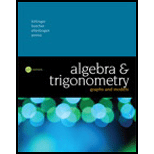
Algebra and Trigonometry: Graphs and Models (6th Edition)
6th Edition
ISBN: 9780134179049
Author: Marvin L. Bittinger, Judith A. Beecher, David J. Ellenbogen, Judith A. Penna
Publisher: PEARSON
expand_more
expand_more
format_list_bulleted
Question
Chapter J.23, Problem 1E
To determine
To compute: The value of the expression
Expert Solution & Answer
Want to see the full answer?
Check out a sample textbook solution
Chapter J Solutions
Algebra and Trigonometry: Graphs and Models (6th Edition)
Ch. J.1 - In Exercises 1-6, consider the numbers
6, −2.45,...Ch. J.1 - In Exercises 1–6, consider the numbers
6, −2.45,...Ch. J.1 - In Exercises 1–6, consider the numbers
6, −2.45,...Ch. J.1 - In exercises 1–6, consider the numbers
6, −2.45,...Ch. J.1 - Prob. 5ECh. J.1 - In Exercises 1–6, consider the numbers
6, −2.45,...Ch. J.2 - Name the property illustrated by the sentence.
1....Ch. J.2 - Prob. 2ECh. J.2 - Prob. 3ECh. J.2 - Prob. 4E
Ch. J.2 - Prob. 5ECh. J.2 - Prob. 6ECh. J.2 - Prob. 7ECh. J.2 - Prob. 8ECh. J.2 - Prob. 9ECh. J.2 - Prob. 10ECh. J.3 - Classify the inequality as true or false.
1. 9 <...Ch. J.3 - Prob. 2ECh. J.3 - Prob. 3ECh. J.3 - Prob. 4ECh. J.3 - Prob. 5ECh. J.3 - Prob. 6ECh. J.4 - Simplify.
1. |−98|
Ch. J.4 - Prob. 2ECh. J.4 - Prob. 3ECh. J.4 - Prob. 4ECh. J.4 - Prob. 5ECh. J.4 - Prob. 6ECh. J.4 - Prob. 7ECh. J.4 - Prob. 8ECh. J.5 - Compute and simplify.
1. 8 − (−11)
Ch. J.5 - Prob. 2ECh. J.5 - Prob. 3ECh. J.5 - Prob. 4ECh. J.5 - Prob. 5ECh. J.5 - Prob. 6ECh. J.5 - Prob. 7ECh. J.5 - Prob. 8ECh. J.5 - Prob. 9ECh. J.5 - Prob. 10ECh. J.5 - Prob. 11ECh. J.5 - Prob. 12ECh. J.5 - Prob. 13ECh. J.5 - Prob. 14ECh. J.5 - Prob. 15ECh. J.6 - Write interval notation.
1. {x| −5 ≤ x ≤ 5}
Ch. J.6 - Prob. 2ECh. J.6 - Prob. 3ECh. J.6 - Prob. 4ECh. J.6 - Prob. 5ECh. J.6 - Prob. 6ECh. J.6 - Prob. 7ECh. J.6 - Prob. 8ECh. J.6 - Prob. 9ECh. J.6 - Prob. 10ECh. J.7 - Prob. 1ECh. J.7 - Prob. 2ECh. J.7 - Prob. 3ECh. J.7 - Prob. 4ECh. J.7 - Prob. 5ECh. J.7 - Prob. 6ECh. J.7 - Prob. 7ECh. J.7 - Prob. 8ECh. J.7 - Prob. 9ECh. J.7 - Prob. 10ECh. J.8 - Prob. 1ECh. J.8 - Prob. 2ECh. J.8 - Prob. 3ECh. J.8 - Prob. 4ECh. J.8 - Prob. 5ECh. J.8 - Prob. 6ECh. J.8 - Prob. 7ECh. J.8 - Prob. 8ECh. J.9 - Calculate.
1. 3 + 18 ÷ 6 − 3
Ch. J.9 - Calculate.
2. 5 ∙ 3 + 8 ∙ 32 + 4(6 − 2)
Ch. J.9 - Calculate.
3. 5(3 – 8 ∙ 32 + 4 ∙ 6 − 2)
Ch. J.9 - Calculate.
4. 16 ÷ 4 ∙ 4 ÷ 2 ∙ 256
Ch. J.9 - Calculate.
5. 26 ∙2−3 ÷ 210 ÷ 2−8
Ch. J.9 - Prob. 6ECh. J.9 - Prob. 7ECh. J.9 - Prob. 8ECh. J.10 - Determine the degree of the polynomial.
1. 5 − x6
Ch. J.10 - Prob. 2ECh. J.10 - Prob. 3ECh. J.10 - Prob. 4ECh. J.10 - Prob. 5ECh. J.10 - Prob. 6ECh. J.10 - Prob. 7ECh. J.10 - Prob. 8ECh. J.11 - Prob. 1ECh. J.11 - Prob. 2ECh. J.11 - Prob. 3ECh. J.11 - Prob. 4ECh. J.11 - Prob. 5ECh. J.12 - Prob. 1ECh. J.12 - Prob. 2ECh. J.12 - Prob. 3ECh. J.12 - Prob. 4ECh. J.12 - Prob. 5ECh. J.12 - Prob. 6ECh. J.13 - Prob. 1ECh. J.13 - Prob. 2ECh. J.13 - Prob. 3ECh. J.13 - Prob. 4ECh. J.13 - Prob. 5ECh. J.13 - Prob. 6ECh. J.14 - Prob. 1ECh. J.14 - Prob. 2ECh. J.14 - Prob. 3ECh. J.14 - Prob. 4ECh. J.14 - Prob. 5ECh. J.14 - Prob. 6ECh. J.14 - Factor the trinomial.
7. 2n2 − 20n − 48
Ch. J.14 - Prob. 8ECh. J.14 - Prob. 9ECh. J.14 - Prob. 10ECh. J.14 - Prob. 11ECh. J.14 - Prob. 12ECh. J.15 - Prob. 1ECh. J.15 - Prob. 2ECh. J.15 - Prob. 3ECh. J.16 - Factor the difference of squares.
1. z2 − 81
Ch. J.16 - Prob. 2ECh. J.16 - Prob. 3ECh. J.16 - Prob. 4ECh. J.16 - Prob. 5ECh. J.16 - Prob. 6ECh. J.16 - Prob. 7ECh. J.16 - Factor the sum or the difference of cubes.
8. m3 −...Ch. J.16 - Factor the sum or the difference of cubes.
9. 3a5...Ch. J.16 - Factor the sum or the difference of cubes.
10. t6...Ch. J.17 - Prob. 1ECh. J.17 - Prob. 2ECh. J.17 - Prob. 3ECh. J.17 - Prob. 4ECh. J.17 - Prob. 5ECh. J.17 - Prob. 6ECh. J.17 - Prob. 7ECh. J.17 - Prob. 8ECh. J.18 - Prob. 1ECh. J.18 - Prob. 2ECh. J.18 - Prob. 3ECh. J.18 - Prob. 4ECh. J.18 - Prob. 5ECh. J.18 - Prob. 6ECh. J.19 - Prob. 1ECh. J.19 - Prob. 2ECh. J.19 - Prob. 3ECh. J.19 - Prob. 4ECh. J.19 - Prob. 5ECh. J.19 - Prob. 6ECh. J.19 - Prob. 7ECh. J.19 - Prob. 8ECh. J.20 - Prob. 1ECh. J.20 - Prob. 2ECh. J.20 - Prob. 3ECh. J.20 - Prob. 4ECh. J.20 - Prob. 5ECh. J.20 - Prob. 6ECh. J.21 - Find the domain of the rational expression.
1.
Ch. J.21 - Prob. 2ECh. J.21 - Prob. 3ECh. J.21 - Prob. 4ECh. J.21 - Simplify.
5.
Ch. J.21 - Simplify.
6.
Ch. J.22 - Multiply or divide and, if possible, simplify.
1....Ch. J.22 - Prob. 2ECh. J.22 - Prob. 3ECh. J.22 - Prob. 4ECh. J.22 - Multiply or divide and, if possible, simplify.
5....Ch. J.22 - Multiply or divide and, if possible, simplify.
6....Ch. J.23 - Add or subtract and, if possible, simplify.
1.
Ch. J.23 - Prob. 2ECh. J.23 - Prob. 3ECh. J.23 - Prob. 4ECh. J.23 - Add or subtract and, if possible, simplify.
5.
Ch. J.23 - Add or subtract and, if possible, simplify.
6.
Ch. J.24 - Simplify.
1.
Ch. J.24 - Prob. 2ECh. J.24 - Simplify.
3.
Ch. J.24 - Prob. 4ECh. J.24 - Simplify.
5.
Note: b − a = −1(a − b)
Ch. J.25 - Simplify. Assume that no radicands were formed by...Ch. J.25 - Prob. 2ECh. J.25 - Prob. 3ECh. J.25 - Prob. 4ECh. J.25 - Prob. 5ECh. J.25 - Prob. 6ECh. J.25 - Prob. 7ECh. J.25 - Simplify. Assume that no radicands were formed by...Ch. J.25 - Simplify. Assume that no radicands were formed by...Ch. J.25 - Prob. 10ECh. J.25 - Prob. 11ECh. J.25 - Prob. 12ECh. J.25 - Simplify. Assume that no radicands were formed by...Ch. J.25 - Prob. 14ECh. J.25 - Prob. 15ECh. J.25 - Prob. 16ECh. J.25 - Simplify. Assume that no radicands were formed by...Ch. J.25 - Simplify. Assume that no radicands were formed by...Ch. J.25 - Prob. 19ECh. J.25 - Prob. 20ECh. J.26 - Rationalize the denominator.
1.
Ch. J.26 - Rationalize the denominator.
2.
Ch. J.26 - Prob. 3ECh. J.26 - Rationalize the denominator.
4.
Ch. J.26 - Prob. 5ECh. J.26 - Prob. 6ECh. J.26 - Prob. 7ECh. J.26 - Rationalize the denominator.
8.
Ch. J.27 - Convert to radical notation and, if possible,...Ch. J.27 - Prob. 2ECh. J.27 - Convert to radical notation and, if possible,...Ch. J.27 - Prob. 4ECh. J.27 - Convert to radical notation and, if possible,...Ch. J.27 - Prob. 6ECh. J.27 - Prob. 7ECh. J.27 - Prob. 8ECh. J.27 - Prob. 9ECh. J.27 - Prob. 10ECh. J.27 - Simplify and then, if appropriate, write radical...Ch. J.28 - Prob. 1ECh. J.28 - Prob. 2ECh. J.28 - Prob. 3ECh. J.28 - Prob. 4ECh. J.28 - Prob. 5E
Knowledge Booster
Learn more about
Need a deep-dive on the concept behind this application? Look no further. Learn more about this topic, algebra and related others by exploring similar questions and additional content below.Recommended textbooks for you
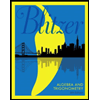 Algebra and Trigonometry (6th Edition)AlgebraISBN:9780134463216Author:Robert F. BlitzerPublisher:PEARSON
Algebra and Trigonometry (6th Edition)AlgebraISBN:9780134463216Author:Robert F. BlitzerPublisher:PEARSON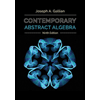 Contemporary Abstract AlgebraAlgebraISBN:9781305657960Author:Joseph GallianPublisher:Cengage Learning
Contemporary Abstract AlgebraAlgebraISBN:9781305657960Author:Joseph GallianPublisher:Cengage Learning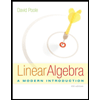 Linear Algebra: A Modern IntroductionAlgebraISBN:9781285463247Author:David PoolePublisher:Cengage Learning
Linear Algebra: A Modern IntroductionAlgebraISBN:9781285463247Author:David PoolePublisher:Cengage Learning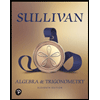 Algebra And Trigonometry (11th Edition)AlgebraISBN:9780135163078Author:Michael SullivanPublisher:PEARSON
Algebra And Trigonometry (11th Edition)AlgebraISBN:9780135163078Author:Michael SullivanPublisher:PEARSON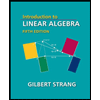 Introduction to Linear Algebra, Fifth EditionAlgebraISBN:9780980232776Author:Gilbert StrangPublisher:Wellesley-Cambridge Press
Introduction to Linear Algebra, Fifth EditionAlgebraISBN:9780980232776Author:Gilbert StrangPublisher:Wellesley-Cambridge Press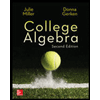 College Algebra (Collegiate Math)AlgebraISBN:9780077836344Author:Julie Miller, Donna GerkenPublisher:McGraw-Hill Education
College Algebra (Collegiate Math)AlgebraISBN:9780077836344Author:Julie Miller, Donna GerkenPublisher:McGraw-Hill Education

Algebra and Trigonometry (6th Edition)
Algebra
ISBN:9780134463216
Author:Robert F. Blitzer
Publisher:PEARSON

Contemporary Abstract Algebra
Algebra
ISBN:9781305657960
Author:Joseph Gallian
Publisher:Cengage Learning

Linear Algebra: A Modern Introduction
Algebra
ISBN:9781285463247
Author:David Poole
Publisher:Cengage Learning

Algebra And Trigonometry (11th Edition)
Algebra
ISBN:9780135163078
Author:Michael Sullivan
Publisher:PEARSON

Introduction to Linear Algebra, Fifth Edition
Algebra
ISBN:9780980232776
Author:Gilbert Strang
Publisher:Wellesley-Cambridge Press

College Algebra (Collegiate Math)
Algebra
ISBN:9780077836344
Author:Julie Miller, Donna Gerken
Publisher:McGraw-Hill Education
Introduction to Integers,Maths - What are integers - English; Author: Mathispower4u;https://www.youtube.com/watch?v=04pURxo-iu0;License: Standard YouTube License, CC-BY
Integers-Middle School Math; Author: MooMooMath and Science;https://www.youtube.com/watch?v=DGWcWtqM_yk;License: Standard YouTube License, CC-BY